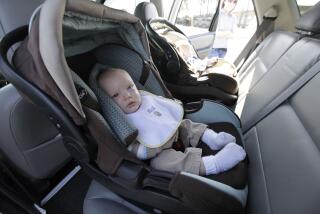Beat Carsickness--Pull Over Often Before It Slams the Brakes on Your Road Trip
- Share via
A car trip to the mountains on winding, scenic roads sounds like the perfect holiday getaway.
But it can become pure torture if some passengers are prone to carsickness, a form of motion sickness that can make people feel nauseated, drowsy and lightheaded.
Carsickness is most likely to affect children under 10, but not everyone outgrows the ailment. About one in 10 adults gets the car queasies too, experts say.
Motion sickness is believed to be caused by excessive stimulation of the vestibular apparatus in the inner ear, which helps control balance. The brain, in turn, gets conflicting signals, explains Dr. Fred Linthicum Jr., an otologist and chief of histopathology at the House Ear Institute in Los Angeles.
“As you are riding in a car, your eyes tell you [that] you are moving 60 miles per hour,” he says. But your body is in contact with the seat, giving your brain another message. The moving horizon, poor ventilation and anxiety about getting sick can act in concert to bring on an attack.
Similarly, Linthicum says, passengers prone to carsickness should not read while the vehicle is moving, because that can also send conflicting signals to the brain.
Fortunately, there are many over-the-counter and prescription medicines to prevent motion sickness. Among the off-the-shelf rememdies are Dramamine (dimenhydrinate), Bonine (meclizine) and Marezine (cyclizine).
In a study at Pennsylvania State University, researchers compared Dramamine and Marezine in 23 subjects and found both drugs similarly effective and Dramamine more sedating. Publishing their results in the journal Aviation, Space and Environmental Medicine last year, the researchers concluded that the effectiveness of Dramamine may be related to its sedative properties, whereas Marezine may work more directly on the stomach and thus be better at preventing gastrointestinal symptoms.
Available by prescription in various forms is the drug scopolamine. The Transderm Scop patch, worn behind the ear, is impregnated with scopolamine, which is released slowly over a 72-hour period. Scopolamine can be taken orally as Scopace, a tablet that contains about 0.4 milligram of the drug. Scopolamine has side effects, however, including drowsiness, dry mouth and blurred vision, and is not generally recommended for children.
Motion-sickness drugs must be taken before travel; package instructions stipulate how soon before departure to take the first dose.
“If you wait until the onset of symptoms, the medicine is useless,” Linthicum says.
An alternative approach to treating motion sickness calls for acupressure or wrist bands (sold over the counter) that stimulate a specific acupuncture point thought to control nausea. The proper point is two finger widths above the wrist crease, toward the elbow on the palm side of the hand, between the major tendons. Adherents contend that simply pressing on this point can bring some relief.
There are other, more traditional measures. Adults prone to carsickness should drive rather than ride whenever possible, says Dr. Scott Bateman, a family practice doctor at the UCLA Medical Group/Malibu and staff member at the Santa Monica-UCLA Medical Center. But he cautions his patients not to drive after taking motion-sickness medicine.
For passengers who tend to get motion sickness, sitting in the front seat while looking straight ahead is preferable to sitting in back, he adds, explaining that “the back seat is worse because there is no focus point.”
If avoiding the back seat is impossible, Bateman suggests covering the windows in back with shades. If the windows are not covered, back-seat passengers should avoid looking out the sides, he says, because a constant lateral gaze, with scenery zipping by, will make them feel worse.
Staying calm can help minimize symptoms too, Bateman has found. The more anxious those with a history of carsickness become, he says, the worse the symptoms tend to be.
Before embarking, passengers with a history of motion sickness should eat a small meal of low-fat foods, such as pasta, fruit or crackers, Bateman and others advise.
If children often feel ill on car rides, despite such precautions, Bateman says, parents should check the vehicle’s exhaust system to be sure escaping fumes are not nauseating passengers.
Which type of vehicle is easier on a carsick-prone tummy? Experts disagree. Whereas Bateman tells queasy patients to avoid low-slung sports cars, Linthicum believes that luxury cars are the worst because going over bumps in them causes a softer but longer-lasting ripple effect. He says vehicles with a “harder” drive, including sport-utility vehicles, are probably easier on those with motion sickness because the effects of going over bumps are over more quickly.
Whatever the vehicle, doctors say, frequent stops are recommended when passengers who are prone to carsickness are on board. Getting out, stretching and breathing fresh air every few hours can minimize the nausea.
Highway 1 contributor Kathleen Doheny can be reached vie e-mail at kdoheny@compuserve.com.





